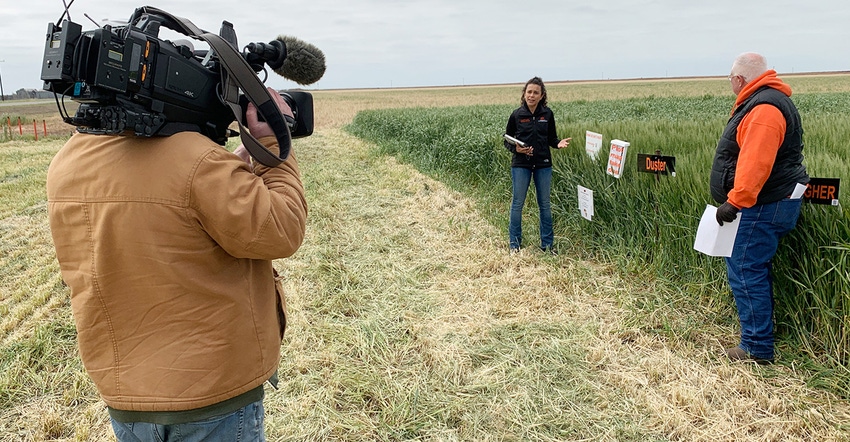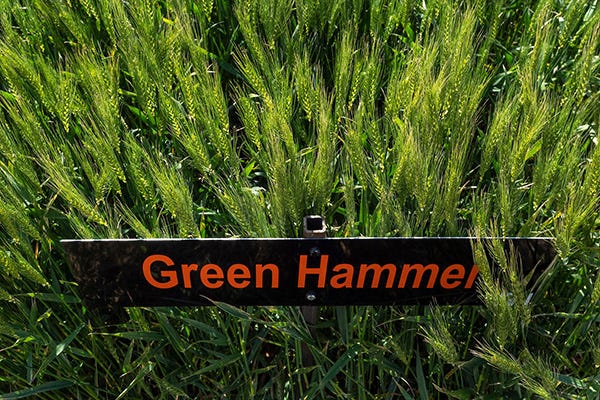
Social distancing mandates may have cancelled field days, but wheat growers can get a sneak peek of Oklahoma State University’s 2020 wheat tour virtually starting April 25 on OSU Extension’s weekly agricultural television show SUNUP.
“This is the time when producers should be looking at how wheat varieties are performing in their areas and the OSU Wheat Field Day historically is one of the main sources of unbiased information wheat growers use to learn about those varieties,” said Amanda de Oliveira Silva, OSU Extension small grains specialist. “People can’t come in person this year so we’re going virtual, starting with a sneak peek on SUNUP.”
The program airs 7:30 a.m. Saturday and 6 a.m. Sunday on OETA, and then is made available online. Viewers can catch segments directly from the SUNUP site, through OState TV and on the YouTube channel.
Silva said the OSU Virtual Wheat Field Day should be available online by the week of April 27. The online material will enable producers to view footage of about 40 wheat varieties and hear explanations of characteristics such as yield potential, disease resistance and tolerance to acid soils and lodging. The collection of electronic media is expected to keep growing with additional content submitted from across the state.
“We also encourage people to go out and walk around our test plots, as social distancing can be maintained; we just can’t have everyone there at the same time, as would happen at a field day,” Silva said. “Besides the variety signs, we left copies of the plot maps for all our wheat variety trials, which are spread across 20 counties in Oklahoma, to help people do a self-guided tour.”
OSU Extension historically has received positive feedback from producers about the importance of such demonstration events. One of the more popular aspects has been how field tours aid farmers’ operational planning by letting them see varieties still undergoing trial research that might be coming onto the market soon.
 (Green Hammer is one of several varieties developed by Oklahoma State University’s Wheat Improvement Team that will be featured on SUNUP’s sneak peek of the virtual wheat tour. (Photo by Todd Johnson, OSU)
(Green Hammer is one of several varieties developed by Oklahoma State University’s Wheat Improvement Team that will be featured on SUNUP’s sneak peek of the virtual wheat tour. (Photo by Todd Johnson, OSU)

“What is of the most interest to people is not always the top grain-yielding variety but a variety that will provide the best overall production characteristics for their specific farming operations,” said Gary Strickland, OSU Extension dryland cropping systems specialist with the university’s Southwest Research and Extension Center in Altus.
The Oklahoma Wheat Commission is working closely with OSU Extension and the statewide Oklahoma Agricultural Experiment Station system to ensure producers have access to needed data during the growing season. On average, Oklahoma’s wheat industry contributes more than $600 million annually to the state economy.
“With all the pandemic-related challenges going on this growing season, we feel people are taking a greater interest in food production,” OWC Executive Director Mike Schulte said. “A great benefit of the OSU Virtual Wheat Field Day is that it provides a wonderful platform for people to become more educated about what it takes to get food from the field to someone’s table in addition to the benefits it gives wheat growers and related agribusiness operators.”
Research-based wheat production practices are among hundreds of topics featured in OSU Extension fact sheets, available online and through all OSU Extension county offices.
Source: is OSU, which is solely responsible for the information provided and is wholly owned by the source. Informa Business Media and all its subsidiaries are not responsible for any of the content contained in this information asset.
About the Author(s)
You May Also Like




